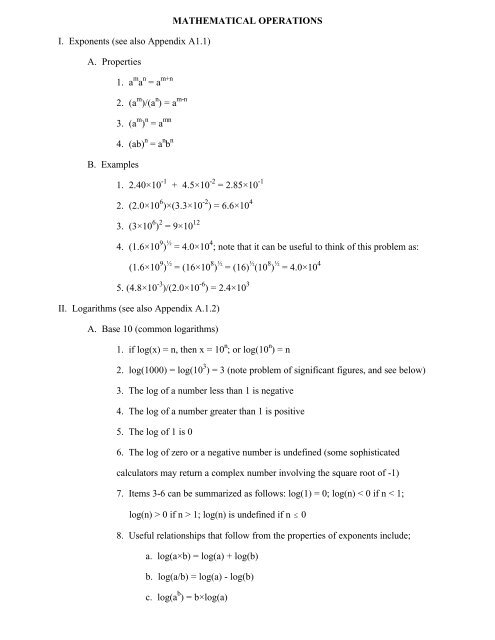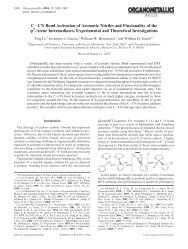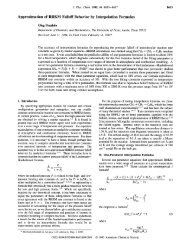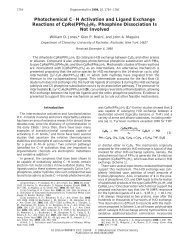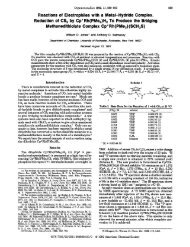MATHEMATICAL OPERATIONS I. Exponents (see also Appendix A1 ...
MATHEMATICAL OPERATIONS I. Exponents (see also Appendix A1 ...
MATHEMATICAL OPERATIONS I. Exponents (see also Appendix A1 ...
Create successful ePaper yourself
Turn your PDF publications into a flip-book with our unique Google optimized e-Paper software.
<strong>MATHEMATICAL</strong> <strong>OPERATIONS</strong><br />
I. <strong>Exponents</strong> (<strong>see</strong> <strong>also</strong> <strong>Appendix</strong> <strong>A1</strong>.1)<br />
A. Properties<br />
1. a m a n = a m+n<br />
2. (a m )/(a n ) = a m-n<br />
3. (a m ) n = a mn<br />
4. (ab) n = a n b n<br />
B. Examples<br />
1. 2.40×10 -1 + 4.5×10 -2 = 2.85×10 -1<br />
2. (2.0×10 6 )×(3.3×10 -2 ) = 6.6×10 4<br />
3. (3×10 6 ) 2 = 9×10 12<br />
4. (1.6×10 9 ) ½ = 4.0×10 4 ; note that it can be useful to think of this problem as:<br />
(1.6×10 9 ) ½ = (16×10 8 ) ½ = (16) ½ (10 8 ) ½ = 4.0×10 4<br />
5. (4.8×10 -3 )/(2.0×10 -6 ) = 2.4×10 3<br />
II. Logarithms (<strong>see</strong> <strong>also</strong> <strong>Appendix</strong> A.1.2)<br />
A. Base 10 (common logarithms)<br />
1. if log(x) = n, then x = 10 n ; or log(10 n ) = n<br />
2. log(1000) = log(10 3 ) = 3 (note problem of significant figures, and <strong>see</strong> below)<br />
3. The log of a number less than 1 is negative<br />
4. The log of a number greater than 1 is positive<br />
5. The log of 1 is 0<br />
6. The log of zero or a negative number is undefined (some sophisticated<br />
calculators may return a complex number involving the square root of -1)<br />
7. Items 3-6 can be summarized as follows: log(1) = 0; log(n) < 0 if n < 1;<br />
log(n) > 0 if n > 1; log(n) is undefined if n # 0<br />
8. Useful relationships that follow from the properties of exponents include;<br />
a. log(a×b) = log(a) + log(b)<br />
b. log(a/b) = log(a) - log(b)<br />
c. log(a b ) = b×log(a)
B. Examples<br />
1. log(1000) = log(10 3 ) = 3<br />
2. log(0.001) = log(10 -3 ) = -3<br />
3. log(0.0422) = log(4.22×10 -2 ) = log(4.22) + log(10 -2 ) = 0.625 - 2 = -1.375<br />
4. log(422) = log(4.22×10 2 ) = log(4.22) + log(10 2 ) = 0.625 + 2 = 2.625<br />
5. If a = 100 and b = 0.001, log(a×b) = log(a) + log(b) = 2 + -3 = -1, and<br />
log(a/b) = log(a) - log(b) = 2 - (-3) = 5.<br />
C. Antilogarithm (calculators often label this key 10 x , for good reason)<br />
antilog(x) = 10 x<br />
antilog(2.625) = 10 2.625 = 422<br />
antilog(-1.375) = 10 -1.375 = 0.0422<br />
C. Base e or natural logarithms, ln(x)<br />
if ln(x) = n, then x = e n , where e = 2.718282; or ln(e n ) = n<br />
ln(x) = 2.303log(x), where 2.303 = ln(10). This can be <strong>see</strong>n by considering x =<br />
10 n , so log(x) = n. ln(x) = ln(10 n ) = n×ln(10) from II.A.8.c. But n = log(x) so<br />
ln(x) = ln(10)×log(x).<br />
III. Significant Figures (<strong>see</strong> <strong>also</strong> <strong>Appendix</strong> A.1.6)<br />
A. Examples<br />
3.1416; five significant figures<br />
0.00023; two significant figures (2.3×10 -4 )<br />
0.860; three significant figures (8.6×10 -1 is different than 8.60×10 -1 )<br />
B. Basic Operations<br />
8.65 - 0.024 = 8.63<br />
5.24/1.1 = 5.7<br />
1/9 = 0.11 in spite of what your calculator may say<br />
C. Functions<br />
If y is a function of x, i.e. y = f(x), the number of significant figures in y need not<br />
equal the number of significant figures in x. For example, log(422) = 2.625; 10 2.62<br />
= 417, 10 2.63 = 427, 10 2.625 = 421.7.
IV.<br />
Quadratic Equations (<strong>see</strong> <strong>also</strong> <strong>Appendix</strong> A.1.4)<br />
ax 2 + bx + c = 0 represents a general quadratic equation, where a, b, c can be positive,<br />
negative or zero. There are always two solutions to this equation, given by<br />
x = [-b ± (b 2 - 4ac) ½] /2a. Note that b 2 - 4ac must be positive to give real answers,<br />
otherwise the answers will be complex, involving the square root of -1. Some calculators<br />
are programed to do this rather automatically, and we will discuss various approximate<br />
methods in class.<br />
V. Temperature Scales<br />
Celsius, ET (Centigrade)<br />
Fahrenheit, EF<br />
Kelvin, K (note the degree sign, E, is NOT used with Kelvin temperatures)<br />
K = EC + 273<br />
EC = 5(EF - 32)/9<br />
EF = 9(EC)/5 + 32


